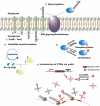Strategies for efficient production of recombinant proteins in Escherichia coli: alleviating the host burden and enhancing protein activity
- PMID: 36109777
- PMCID: PMC9479345
- DOI: 10.1186/s12934-022-01917-y
Strategies for efficient production of recombinant proteins in Escherichia coli: alleviating the host burden and enhancing protein activity
Abstract
Escherichia coli, one of the most efficient expression hosts for recombinant proteins (RPs), is widely used in chemical, medical, food and other industries. However, conventional expression strains are unable to effectively express proteins with complex structures or toxicity. The key to solving this problem is to alleviate the host burden associated with protein overproduction and to enhance the ability to accurately fold and modify RPs at high expression levels. Here, we summarize the recently developed optimization strategies for the high-level production of RPs from the two aspects of host burden and protein activity. The aim is to maximize the ability of researchers to quickly select an appropriate optimization strategy for improving the production of RPs.
Keywords: Escherichia coli; Host burden; Inclusion bodies; Post-translational modification; Recombinant protein.
© 2022. The Author(s).
Conflict of interest statement
The authors declare that they have no competing interests.
Figures




References
-
- Puetz J, Wurm FM. Recombinant proteins for industrial versus pharmaceutical purposes: a review of process and pricing. Processes. 2019;7:476–484. doi: 10.3390/pr7080476. - DOI
-
- Industrial Enzymes Market. https://www.marketsandmarkets.com/Market-Reports/industrial-enzymes-mark.... Accessed Jan 2022.
-
- Deo S, Turton KL, Kainth T, Kumar A, Wieden H-J. Strategies for improving antimicrobial peptide production. Biotechnol Adv. 2022:107968–84. - PubMed
Publication types
MeSH terms
Substances
LinkOut - more resources
Full Text Sources

